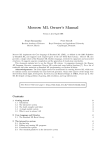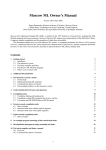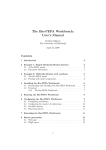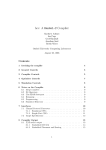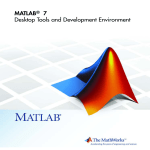Download Moscow ML .Net Internals
Transcript
Moscow ML .Net Internals
Version 0.9.0 of November 2003
Niels Jørgen Kokholm, IT University of Copenhagen, Denmark
Peter Sestoft, Royal Veterinary and Agricultural University, Copenhagen, Denmark
This document describes some of the internals of Moscow ML .Net 0.9.0, a port of Moscow ML 2.00
to the .Net platform. If you intend to modify Moscow ML .Net, you may find this document useful.
Otherwise, read the Moscow ML .Net User’s Manual [1] instead.
Contents
1 Structure of compiled files
1.1 Compiled interfaces
1.2 Compiled implementation files
1.3 Unit loading
1.4 External linking of ML values
1
1
2
3
3
2 ML value representation details
2.1 Numeric types
2.2 String types
2.3 Block types
2.4 Closure types
2.5 Other types
3
3
3
4
4
5
3 Closure implementation details
3.1 Function representation
3.2 Function application
3.3 The dispatcher methods
3.4 Tail calls
3.5 Large argument counts
6
6
6
6
7
8
4 Exception handling
4.1 ML exceptions are CLR exceptions
4.2 An alternative implementation of ML exceptions
8
8
9
1 Structure of compiled files
1.1 Compiled interfaces
A compiled interface file has suffix .ui and contains an MD5 checksum followed by a serialized ML
signature value. The serialization is hand-coded (this is around 10 times faster than the built-in .Net
serialization) and very similar to the Moscow ML 2.0 serialization, although not binary compatible.
1
1.2 Compiled implementation files
A compiled implementation file generated by mosmlnetc is a .Net assembly: either an executable (.exe)
or a library (.dll). It may be instructive to look at the result of disassembling such a file using ildasm
while reading this section.
A compiled implementation file contains an assembly manifest that includes strongname references
to mscorlib.dll and Mosml.Runtime.dll and any other assemblies referenced via the prim_val or
clr_val mechanisms.
All code compiled from an implementation file, unitid.sml, will belong to the Mosml.unitid
namespace. This will hold one class called main; one class for each toplevel declaration (roughly),
named INIT_i where i is the declaration’s sequence number; closure classes named CL_i_j where i
is the enclosing declaration’s sequence number and j is the closure’s position in that declaration; and
classes named ENV_CL_i_j for holding the free variables of closures:
namespace Mosml.unitid {
public class main {...}
public class INIT_001 {...}
...
public class INIT_N {...}
public class CL_001___1 {...}
public class ENV_CL_001___1 {...}
public class CL_001___2 {...}
...
}
Closure classes are described in Section 3 below. An INIT_i class will just have a single method Eval()
which, when invoked, will evaluate the corresponding declaration.
The main class of a compiled unit will look as if declared like this:
using System.Collections;
using Mosml;
public class main {
public static string checksum;
public static Dependency[] dependencies;
public static Hashtable exports;
public static Value[] globals;
public static Value[] imports;
public static void init_imports(Hashtable loaded_units);
public static void module_init(Hashtable loaded_units);
}
The checksum field is initialised to the corresponding .ui file checksum. The dependencies array
is initialized with pairs of the form (checksumX,unitidX) for each unit that this unit loads directly.
The globals field will hold global values declared as the unit is evaluated. The exports field will
map exported names to indexes into globals. The imports field will cache values referenced from
other units and will be filled when init_imports(...) is run. Finally, module_init(...) will run
init_imports(...) and then all INIT_i.Eval() methods of this unit.
If unitid.sml was compiled in exe mode the main class will furthermore have a static Main()
method that contains an .entrypoint assembly directive and when invoked will set up Runtime.libdirs,
load and evaluate any ML dependencies and finally invoke module_init().
2
1.3 Unit loading
Loading of a unit will load any units on which it depends, and then invoke the unit’s module_init(),
which in turn calls the unit’s init_imports(...) and then all its INIT_i.Eval() methods.
1.4 External linking of ML values
An SML function can be called from a C# program or another .Net language using the
Runtime.get_unit_val utility function as described in [1, Section 3.3].
2 ML value representation details
All representatives of ML values belong to subclasses of the abstract class Mosml.Value, or just Value,
defined in Mosml.runtime.dll with the source code in src/runtime/Values.cs:
Value
MLBlock0
MLBlock1
MLBlock2
MLInt
MLFloat
MLAbstractString
MLClosure_
MLInChannel
MLWeak
ILG
MLClosure
MLTextReader
MLWeakVector
RTCG
MLString
MLInFileStream
MLClrAny
MLClosure1
MLBlock3
MLOutChannel
MLByteArray
MLClosure2
MLBlock4
MLCharArray
MLTextWriter
MLClosure...
MLOutFileStream
MLBlock5
MLClosure10
MLBlock6
MLClosureinf
MLBlockinf
The Value class itself just contains a few utility static fields and a few abstract method declarations, the
most important of which is the eqvals method for testing equality of ML values.
2.1 Numeric types
The integral ML types int, word, word8, char are all represented by MLInt that simply is Value with
a public System.Int32 field val added. An ML value corresponding to a .Net int is created using the
MLInt(int) constructor; the .Net int can be recovered again from the val field.
Similarly, a floating-point number (of ML type real) is represented as an MLFloat that has a System.Double
field called val.
2.2 String types
An ML string is represented by a concrete subclass of MLAbstractString. Most strings will be represented by MLString that is just Value with a System.String field val added. Inside string libraries and
IO libraries, string value representatives may be created as MLByteArray or MLCharArray objects (with
3
mutable val fields of type byte[] respectively char[]) and such representatives may leak from the libraries. Normally one translates a .Net string to an ML value representative using the MLString(string)
constructor and translates the other way by the ToString() method valid on all of MLAbstractString.
The situation is currently a little messy. The strings should really be considered arrays of 8-bit characters, but use the 16-bit .Net string and char types to a large extent for representation.
2.3 Block types
ML tuples, records, datatypes, refs, vectors and arrays are all represented as “blocks”, which should
be thought of as Value[]s with an associated 8-bit tag field. To save almost half the object creations
and deletions by block operations, the most obvious implementation of blocks has been modified to the
following chinese box implementation (simplified view):
public class MLBlock0 :
public byte tag;
public int len;
public Value this[int
}
public class MLBlock1 :
public Value v0;
}
public class MLBlock2 :
public Value v1;
}
...
public class MLBlock6 :
public Value v5;
}
public class MLBlockinf
public Value[] vinf;
}
Value {
i];
MLBlock0 {
MLBlock1 {
MLBlock5 {
: MLBlock6 {
We need the deep hierarchy because the compiler back end does not know when accessing, say field
number 3 (i.e. v2) of a block, which precise type the given block is, just that it has the specific field v2,
and thus must be represented by an MLBlock3 or a subclass.
Tuples are represented directly with the tuple elements as block fields in order and tag 0. Records
are represented as tuples in alphabetic order of the labels. Datatype values are represented as blocks with
the tag being the rank in alphabetic order of the constructor name (starting with 0) and the fields being
the elements of the toplevel tuple in the constructor argument. References are represented as blocks with
tag 250 and the referenced element as single field. Vectors are represented just like tuples and arrays are
vector refs.
The easiest way to access the tag is to access the tag field. The easiest way to access individual fields
is to use the this[int i] method via array syntax in C#. There are suitable constructors for all the block
types.
2.4 Closure types
SML function values (closures) are represented by subclasses of the abstract MLClosureXXX classes, with
the XXX corresponding to the number of arguments in the original fun declaration on which the closure
is based. (In Moscow ML curried function declarations are, for efficiency purposes, kept curried and not
translated to non-curried ones before compilation). The MLClosureXXX classes have the relevant number
4
of Value fields for saving arguments supplied in undersaturated calls. Values saved from the function
declaration environment will be saved in fields allocated in the concrete subclasses of the MLClosureXXX.
The MLClosure class defines the common interface of all closure representatives:
Value
Value
...
Value
Value
Eval1(Value arg1);
Eval2(Value arg1, Value arg2);
Eval10(Value arg1, ..., Value arg10);
Evalinf(Value[] args);
An SML function application with M arguments will be compiled to pushing the representatives of
the arguments on the CLR stack and then calling EvalM on the closure representative if M ≤ 10 and
else collecting the representatives of the arguments in a Value[] array and then calling Evalinf on the
closure representative. The number 10 is chosen as a number large enough that the fallback case for large
argument counts should not occur in normal SML code.
MLClosure and the MLClosureXXX have to use the CIL directive “tail.” to make the CLR use tail
calls for efficiency. Therefore these classes cannot be written in (current versions of) C#. Instead, they
are generated as textual CIL assembler by the src/genclosure/genclosure.sml program of the source
distribution. For pedagogical reasons only, the source distribution contains mockup C# source code correspoding to part of the generated CIL code; this mockup is in src/doc/internals/closure_mockup.cs.
The MLClosure_ class in the figure above is a trivial intermediate class defined in src/runtime/Values.cs
just for defining an abstract Eval1 method for the benefit of a piece of code in src/runtime/Stdlib.cs
that calls back to ML from C# using this interface. The MLClosure_ enables the src/runtime/*.cs
files to be compiled independently of the detailed CIL implementation of MLClosure.
See Section 3 for more details on the closure implementation.
2.5 Other types
The types MLInChannel, MLOutChannel, MLInFileStream, MLTextReader, MLOutFileStream and
MLTextWriter represent IO channels as used in the BasicIO, TextIO, BinIO and NonstdIO library
units. The first two mentioned classes are abstract utility classes, while the other four are simple wrappers of their CLR counterparts.
The SML types Weak.weak and Weak.array are represented by MLWeak and MLWeakVector. They
are simple wrappers of a System.WeakReference respectively a System.WeakReference[] array.
MLDirHandle is used for FileSys.dirstream SML values. The CLR does not seem to have any
analogue of the usual C opendir etc. interface, and so MLDirHandle actually caches the whole directory
listing in an internal array on creation.
RTCG and ILG are used for runtime code generation, inside the compiler/interactive system. The RTCG
type is a conglomerate of an assemblybuilder, a modulebuilder together with typebuilders and methodbuilders as required. The ILG type wraps an IL generator for a specific method.
MLExcReturn has been used for experimental work with exception handling see Section 4.
MLClrAny is used for representing values of the special prim_types created by clr_val, see [1]. It
contains an object field for the CLR object and a string field for the (full) CLR type name corresponding to the prim_type of the SML value represented.
5
3 Closure implementation details
3.1 Function representation
Moscow ML .Net functions are represented by objects of subclasses of the abstract classes Mosml.MLClosureN,
N=1,... defined in Mosml.Runtime.dll based on source code in the files src/runtime/Values.cs
and src/runtime/MLClosure.il as noted above.
The Mosml.MLClosureN classes are themselves subclasses of Mosml.MLClosure.
The function f defined by
fun f x_1 x_2 ... x_N
= ...
will be represented by an object rep_f of a subclass, Rep_f, of Mosml.MLClosureN. Class Rep_f will
implement a method EvalN(Value A_1,...,Value A_N) with a body containing the compiled body of
the definition of f (with the arguments in reverse order, see below). The real name of Rep_f will be something like Mosml.<unitid>.CL_<i>_<j>, where i is the index in the implementaion file unitid.sml of
the toplevel declaration containing the definition of f and j is the index of the definition of f inside said
declaration. A function defined by a partial application of f to n(<N) arguments will be represented by an
object of class Mosml.<unitid>.CL_<i>_<j> too, but with the arguments supplied so far saved in fields
Mosml.MLClosureN::savarg1 to Mosml.MLClosureN::savarg<n>.
The description in the preceding paragraph is not completely correct if N is greater than the value
Cil_glob.large_arg_count (currently 10). In that case Mosml.<unitid>.CL_<i>_<j> will be a sublass of a class Mosml.MLClosureinf. The following discussion will ignore function definitions and applications with more than Cil_glob.large_arg_count arguments. The reader is referred to the source
of Mosml.Runtime.dll for information on this case.
3.2 Function application
A function application
(g e_1 e_2 ... e_N)
will be compiled the following virtual instance call on rep_g:
Mosml.MLClosure::EvalN(rep_e_N,...,rep_e_2,rep_e_1)
The reason for the reverse order is that the compiler back-end will evaluate and push the argument expressions to the stack in increasing order of the index, which in .Net corresponds to the call shown. This
is fine if G were defined by a
fun g x_1 x_2 ... x_N = ...
of the same arity since then the compiled body of G will be called directly. Else a system of dispatcher
methods in the Mosml.MLClosureN classes comes into play.
3.3 The dispatcher methods
The Mosml.MLClosure superclass of all the Mosml.MLClosureN classes has abstract methods
EvalM(Value A_1,...,Value A_M) for M from 1 to Cil_glob.large_arg_count. These methods are
implemented in all Mosml.MLClosureN classes as dispatcher methods that work as follows:
6
1. If the total count of arguments (including already saved ones) is less than N, the newly supplied arguments are saved in savarg<_> fields following any earlier saved arguments in a clone of "this"
and the clone is returned.
2. If the total count of arguments equals N, the relevant Mosml.<unitid>.CL_<i>_<j>::EvalN compiled function body is called by a virtual tail call to Mosml.MLClosureN::EvalN with the earlier
saved arguments and the newly supplied ones as arguments.
3. If the total count of old and new arguments exceeds N, say by M, the relevant compiled function
definition body, Mosml.<unitid>.CL_<i>_<j>::EvalN, is called by a virtual (non-tail) call to
Mosml.MLClosureN::EvalN using the saved and some of the newly supplied arguments. The
return Value must be an MLClosure and is called with the remaining M of the newly supplied
arguments by a virtual tail call to Mosml.MLClosure::EvalM.
This scheme, as described, has the following weakness. In the following situation:
fun f x_1 x_2 ... x_N = ...
val g = f e_1 e_2 ... e_M = ...
(g e’_1 e’_2 ... e’_N)
where M<N, the code generated by the compiler for the application of g will result in erroneously dispatching Mosml.<unitid>.CL_<i>_<j>::EvalN with the arguments of the application of g instead of
correctly dispatching the method Mosml.MLClosureN::EvalN in the base class of Rep_g (which is also
the base class of Rep_f) with these arguments.
The solution chosen is to have a check whether savarg1 != null in the beginning of the body of
Mosml.<unitid>.CL_<i>_<j>::EvalN and in that case make an immediate non-virtual tail call with the
supplied arguments to the dispatcher Mosml.MLClosureN::EvalN. For that to work, the (first) calls in
steps 2. and 3. above must actually start by cloning "this" and set savarg1=null in the clone before
calling (virtually) Mosml.MLClosureN::EvalN on the clone.
The weakness and consequent insertion of guard code in every function body implementation could
be avoided by letting the method implementing the function definition body be called something like
Mosml.<unitid>.CL_<i>_<j>::realEval and letting the first call in steps 2. and 3. be a virtual call to
Mosml.MLClosure::realEval. This would then have the effect that every function application would
be made as 2 CLR method calls. We have chosen to optimize the case of direct manifest calls.
3.4 Tail calls
On the CLR, a method call will be performed as a tail call if prefixed by the tail. directive and immediately followed by a ret instruction (if allowed by code access security). Tail calls on CLR, unlike on
typical runtime systems specially made for functional languages, is not faster than ordinary method calls,
but take roughly the same amount of time. The main advantage of tail calls on CLR is the less stack used
for deeply recursive calls, and perhaps an accompanying better locality of stack references.
We try to make SML tail calls be compiled to CLR tal calls in the following way. The compiler
backend is written in CPS, where the code is generated backwards, so that we always can see the code
which will use the result of the currently emitted code. When we are going to emit a method call, we see
if the next instruction will be a ret and if so insert a tail. prefix of the call or callvirt instruction.
To recognize all/more? tail call opportunities, ret instructions are propagated backwards in the code
stream through branch instruction as much as possible. Special care has been made to allow tail calls
from within an exception handler, the difficulties being that one cannot leave a CLR catch block by a ret,
see Section 4.
Since tail calls in the CLR are much slower than branches, we compile a saturated tail call to a function
within its own body to a branch instead. For such self-tail-calls, the compiler will emit code to place the
arguments in the slots ot the stack allocated for the original call to this closure body (instead of pushing
7
the arguments) and then branch to a label at the start of the compiled closure body. Currently, only let
bound functions with at most 10 curried arguments will have self-tail-calls detected and optimized in this
way. In particular, a fun defined at the outermost evaluation level will not have self-tail-calls optimized.
3.5 Large argument counts
The discussion above ignored the case where a (curried) function definition has a very large (>10) argument count, and the case where a function value is applied to a very large number of arguments.
A closure with more than 10 args in its definition will be a subclass of MLClosureInf. This is completely analogous to the lower MLClosureXXX classes, but the dispatcher methods will save the arguments
not in individual Value fields, but in a Value[] arginf field of MLClosureInf until full and then call
realEval() virtually on the closure class. The concrete implementation of that method will contain the
real compiled closure body expecting to find its arguments in the arginf array field (not on the stack).
When Applying a closure value to more than 10 args, the compiled code will call the concrete
MLClosure.Eval(Value[]) method on an array of the args. If the number of arguments is 10K+M,
with integers K>0 and 0<M≤10, the body of MLClosure.Eval(Value[]) will split up the argument array
into K pieces of size 10 and one piece of size M, call MLClosure.Eval10 virtually K times on the given
closure respectively intermediate results with arguments from the pieces of size 10, and finally tail call
MLClosure.EvalM virtually on the remaining M arguments from the last piece.
In the combined case, one could copy arguments directly from the argument of
MLClosure.Eval(Value[]) to the Value[] arginf field of MLClosureInf, but since these cases are
not supposed to appear in practical code, we have ignored this optimization opportunity.
4 Exception handling
4.1 ML exceptions are CLR exceptions
Moscow ML .Net uses CLR exception handling to implement ML exception handling. ML exception values are represented as refs to certain tuples. Moscow ML .Net defines a CLR class, Mosml.MLException,
a subclass of System.Exception (but not of Mosml.Value), which wraps an ML exception value inside
a CLR exception.
The CLR exception handling architecture imposes some restrictions:
• The CLR evaluation stack must be empty on entry to a try block and on exit from a try or catch
block.
• One can only exit a try or catch block with the leave (for label) instruction or by throwing an
exception.
• It is expensive to throw an exception in CLR.
The first issue is no problem for a language where the exception handling is based on statements, but it
is not hard to violate in SML although rare in practical code. The solution chosen for Moscow ML .Net
is to save the ML evaluation stack in freshly allocated local variables before entering the try block and
restore the stack afterwards – see a little more details below.
The second issue in particular implies that one cannot leave a catch block with a ret instruction,
which means that we cannot propagate ret through branches to a position inside the catch block to
recognize tail call opportunities there. The solution is to have the compiled ML exception handling code
execute outside the catch block and just have a small stub execute inside.
The catch clause of a compiled handle expression always catches System.Exception. The stub code
inside the catch block first calls a utility filter method on the caught exception. If the filter recognizes the
8
CLR exception as either a wrapped ML exception value or a CLR exception that has a corresponding ML
equivalent (like arithmetic overflow), the filter returns the ML exception value, else the original exception
is rethrown and will eventually be caught by the outermost exception handler of the application. The
stub code then stores the ML exception value in a local variable, from where the code outside will load
it, and finally leaves the catch block. Right after the catch block comes the compiled ML handler code.
The following pseudo code illustrates the compiled code for the ML expression e1 handle handlematch:
save ML evaluation stack into CLR local variables (if necessary)
try {
compiled e1
store top of CLR stack in local variable SCRATCH_VALUE
leave LABEL1
}
catch (Exception e) {
translate e to ML exception or rethrow it
store top of CLR stack (the ML exception value) in local variable V_1
leave LABEL2
}
LABEL2:
load local variable V_1
compiled handlematch
store top of CLR stack into local variable SCRATCH_VALUE
LABEL1:
restore ML evaluation stack (if relevant)
load local variable SCRATCH_VALUE
To raise an exception from inside a handled expression in ML, with the notation in the pseudo code
above, the ML exception value is stored in the appropriate local variable, V_1 and then a leave LABEL2
instruction is executed. This avoids the overhead of throwing, catching and filtering a Mosml.MLException.
Raising an exception outside a handler will result in code that wraps the ML exception value inside an
Mosml.MLException, which is subsequently thrown.
4.2 An alternative implementation of ML exceptions
To try to avoid the high overhead of throwing a CLR exception when raising an ML exception outside
of handled expressions, an alternative has been tried for code in a function body. Instead of throwing an
exception, one empties the evaluation stack except for the ML exception value, wraps that in a special
Mosml.MLExcReturn object and executes ret. Then every compiled function application must be immediately followed by code that checks whether the return value is an Mosml.MLExcReturn and in that case
raises the exception: If inside a try block by unwrapping the ML exception value from the return value
and leaving; if not in a try block but still in a function body by once again returning the special value; and
if neither in a try block nor in a function body, by rewrapping the ML exception in a Mosml.MLException
and throwing it. This experimental implementation greatly improved the running time of certain examples
that use exceptions heavily for flow control. However, the idea was abandoned because of its negative
impact on the majority of programs, which do not use exceptions for non-exceptional control flow.
References
[1] N. J. Kokholm and P. Sestoft. Moscow ML .Net User’s manual, version 0.9.0, November 2003.
9











